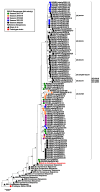Respiratory Syncytial Virus in Adult Patients at a Tertiary Care Hospital in Germany: Clinical Features and Molecular Epidemiology of the Fusion Protein in the Severe Respiratory Season of 2022/2023
- PMID: 38932235
- PMCID: PMC11209376
- DOI: 10.3390/v16060943
Respiratory Syncytial Virus in Adult Patients at a Tertiary Care Hospital in Germany: Clinical Features and Molecular Epidemiology of the Fusion Protein in the Severe Respiratory Season of 2022/2023
Abstract
Following an interseasonal rise in mainly pediatric respiratory syncytial virus (RSV) cases in Germany in 2021, an exceptionally high number of adult cases was observed in the subsequent respiratory season of 2022/2023. The aim of this study was to compare the clinical presentation of RSV infections in the pre- and post-SARS-CoV-2 pandemic periods. Additionally, the local epidemiology of the RSV fusion protein was analyzed at a molecular genetic and amino acid level. RSV detections in adults peaked in calendar week 1 of 2023, 8 weeks earlier than the earliest peak observed in the three pre-pandemic seasons. Although the median age of the adult patients was not different (66.5 vs. 65 years), subtle differences between both periods regarding comorbidities and the clinical presentation of RSV cases were noted. High rates of comorbidities prevailed; however, significantly lower numbers of patients with a history of lung transplantation (p = 0.009), chronic kidney disease (p = 0.013), and immunosuppression (p = 0.038) were observed in the 2022/2023 season. In contrast, significantly more lower respiratory tract infections (p < 0.001), in particular in the form of pneumonia (p = 0.015) and exacerbations of obstructive lung diseases (p = 0.008), were detected. An ICU admission was noted for 23.7% of all patients throughout the study period. Sequence analysis of the fusion protein gene revealed a close phylogenetic relatedness, regardless of the season of origin. However, especially for RSV-B, an accumulation of amino acid point substitutions was noted, including in antigenic site Ø. The SARS-CoV-2 pandemic had a tremendous impact on the seasonality of RSV, and the introduction of new vaccination and immunization strategies against RSV warrants further epidemiologic studies of this important pathogen.
Keywords: RSV; fusion protein; molecular epidemiology; respiratory infections; respiratory viruses.
Conflict of interest statement
The authors declare no conflicts of interest.
Figures





References
-
- Hönemann M., Thiem S., Bergs S., Berthold T., Propach C., Siekmeyer M., Frille A., Wallborn T., Maier M., Pietsch C. In-Depth Analysis of the Re-Emergence of Respiratory Syncytial Virus at a Tertiary Care Hospital in Germany in the Summer of 2021 after the Alleviation of Non-Pharmaceutical Interventions Due to the SARS-CoV-2 Pandemic. Viruses. 2023;15:877. doi: 10.3390/v15040877. - DOI - PMC - PubMed
MeSH terms
Substances
Associated data
- Actions
- Actions
LinkOut - more resources
Full Text Sources
Medical
Miscellaneous

